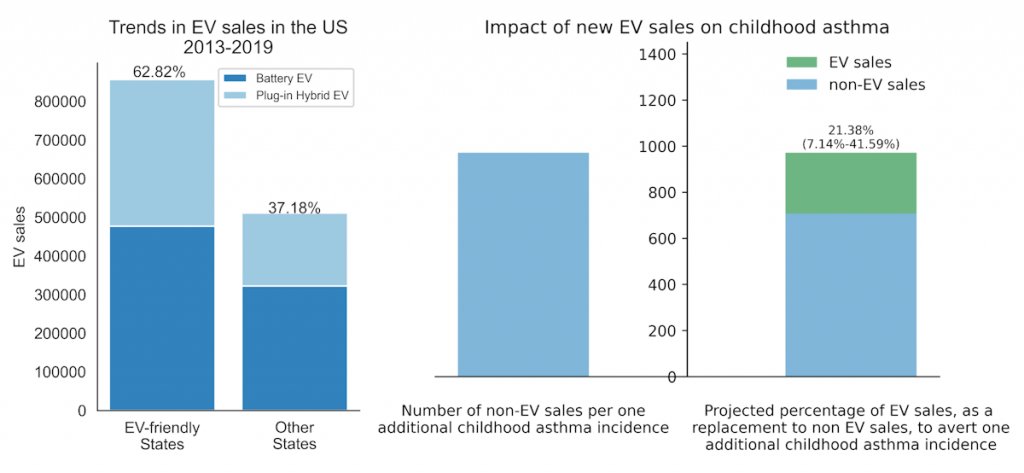Effect of EV sales on childhood asthma rates. Photo provided by Harshit Gujral, Meredith Franklin, Steve Easterbrook (no reuse)
By: Cormac Rea
As Electric Vehicles (EVs) have become a more familiar sight on our streets and highways, one may wonder – has there been a corresponding effect on public health from reduced traffic pollution?
In a paper recently published in the journal, Environmental Research, a Data Sciences Institute (DSI)– funded research team showed that EV sales in the US have had a positive and measurable impact on childhood asthma cases.
“There are many policies in the US that are specifically focus on reducing the burden of asthma, but none of these policies directly address the asthma cases stemming from traffic-related air pollution,” said DSI Doctoral Student Fellow, Harshit Gujral, lead-author of the paper entitled, Emerging evidence for the impact of Electric Vehicle sales on childhood asthma: Can ZEV mandates help?
“Previous research shows that around 18-42 per cent, which is a huge number, of all cases of childhood asthma are attributed to traffic-related air pollution,” he added. “So clearly there is this gap between what is covered in the major policies and actual effectiveness in reducing asthma.”
Along with co-authors and DSI proposal supervisors – Steve Easterbrook (Department of Computer Science, Faculty of Arts and Science, University of Toronto), Meredith Franklin (Department of Statistical Sciences, Faculty of Arts and Science, University of Toronto) and Paul Kushner (Department of Physics, Faculty of Arts and Science, University of Toronto) – Gujral and team were able to employ a cross-department approach that leveraged expertise across various areas and departments.
“It was clear in this case how important it was to bring together different skills and work collaboratively,” said Franklin.
“A key component was wrangling multiple nationwide data sets from various sources and making them work together in one cohesive analysis.”
Gujral also highlighted the DSI funding as creating a pathway for researchers to focus on their work over a sustained period without distraction.
“The DSI provided three-year funding, which meant that I have not had to apply for the funding every year and could just focus on my research and outcomes,” he said.
“The DSI funding created the bandwidth to do exactly that.”
Using childhood asthma as a proxy due to its widespread impact on the population, the research team relied on publicly available datasets from the U.S. Centers for Disease Control and Prevention from 2013-2019, as well as independently obtained EV sales data
“Employing linear mixed models from data science, we were able to find the associations between the sales of EVs and the cases of asthma due to traffic-related air pollution,” explained Gujral.
The research team found that for every 1,000 new gas-powered vehicles sold, there was one new case of childhood asthma. The team also found that replacing approximately 21 per cent of these sales with electric vehicles appeared to be sufficient to halt rising asthma rates caused by new vehicle sales. However, this number varied depending on the state and various factors — such as population density and the number of existing gas-powered vehicles on the road.
For instance, in some states, replacing just seven per cent of gas car sales with electric vehicles might be enough to halt rising asthma rates caused by new vehicle sales. But in other states, 42 per cent of new car sales had to be electric vehicles in order to have any impact.
“A fundamental finding of this research is that the health impacts of EVs will only manifest when EVs replace existing non-EV vehicles,” said Gujral. “If one simply adds more EVs on the road, it might not result in same health benefits.”
The research team’s findings indicate there’s already a measurable public health benefit being seen in the U.S. from the increase of electric vehicles on the road.
“A 36-77 per cent fleet share of electric vehicles should minimize the asthma burden due to reducing the amount of nitrogen dioxide emitted from gas-powered automobiles, but this doesn’t eliminate all the pollutants that are produced by EVs,” said Gujral.
“Next we want to go to the level of ZIP code to understand this problem a bit more and, at the same time, look further at the socioeconomic implication as low-income communities are the ones who are the most disproportionately impacted by traffic-related air pollution.”

